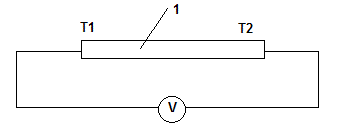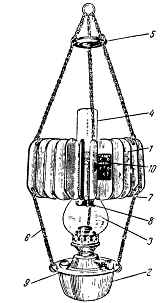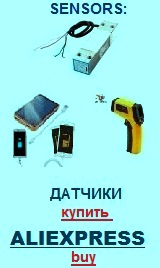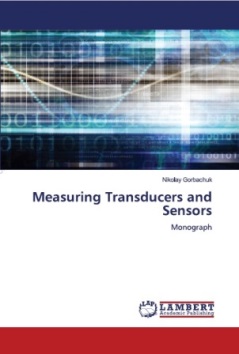Transducers, gauges, sensors - Information portal © 2011 - 2025 Use of material is possible by placing an active link


Thermoelectricity of metals and semiconductors
Thermoelectric converters - generators of EMF
Thermoelectric cooling devices
Thermoelectric transducers
русский / english
Home >> Thermoelectricit >> Thermoelectric converters - generators of EMF
• Information about various converters and sensors of physical quantities, parameters of various physical processes is presented.
• Electrophysical properties and effects in various electrical materials.
• Theory, experimental results, practical application
Thermoelectric converters - generators of EMF
The emergence of the EMF at the ends of the open-circuit consisting of contacts (junctions) of two different semiconductors (conductors) are at different temperatures, a phenomenon called the Seebeck effect. Thermopower in semiconductors can, for example, to observe, using the compound shown in Fig.1 (1- semiconductors).
Fig. 1
Over the years, the Seebeck effect is not found a use in the energy sector. The situation changed in the thirties of the 20th century, when found out that the thermoelectric properties of semiconductors have far superior properties of metals.
In order to use thermoelectricity in the energy sector should be especially suitable efficiency of η. Joffe has shown that N is determined by the values η of the thermoelectric converter:
α - Coefficient of thermal electromotive force,
χ - Thermal conductivity,
σ - Electrical conductivity.
Around the dependence can be expressed:
η ≈ α ^ 2 ⋅ σ / χ ⋅ ΔT
Where ΔT = T2 - T1, T2 - temperature of hot junction, T 1 - temperature of the cold.
The formula shows why long thermoelectricity found no practical use except for temperature measurement. For metals, the parameters determining the thermoelectric power, such that the efficiency for them does not exceed tenths of a percent.
For semiconductors, the values α, χ, σ of η, such that is possible to manufacture thermoelectric converters with relatively high efficiency
To create a thermoelectric semiconductor elements can be used as a conductivity type and n-and p-type converter in one connecting them appropriately.
Single element thermoelectric converters can be represented as shown in Fig. 1.
The first thermoelectric generator, in which thermal energy is transformed into electrical phenomena on the basis of thermoelectric power were created in 1941. During the Second World War, was used for thermoelectric power radio transmitters. They were simply arranged. For example, dozens of semiconductor thermoelements were mounted in the bottom of a special pot. Bowler has been on fire. The temperature of cold junctions of the elements of the generator wondered boiling water, and heated by the hot bottom of the pot.
In the future, and other developed thermoelectric power up to 100 watts or more, and efficiency ≈8%.
Thermoelectric not widely used, although used in some areas of technology. Scientists are conducting research to develop materials and structures can take to improve efficiency of thermoelectric and make them more profitable.
The appearance of thermoelectric TGC-3 (1953 years).
1 - thermal head, 2 - kerosene lamp, 3 - lamp glass, 4 - a metal tube, 5 - suspension device for the thermal head, 6 - a device for hanging oil lamp, 7 - Removable chain, 8 - Heater, 9 - suspension ring, 10 - terminal strip

See also:
CONVERTERS, GAUGES, SENSORS
Information, news, advertising


